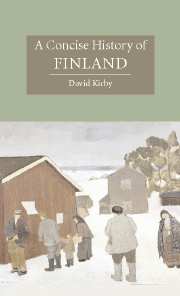Book contents
- Frontmatter
- Dedication
- Contents
- List of illustrations
- Preface
- 1 A medieval marchland
- 2 The Swedish legacy
- 3 From Stockholm to St Petersburg, 1780–1860
- 4 The embryonic state, 1860–1907
- 5 The independent state, 1907–37
- 6 War and peace, 1939–56
- 7 The Kekkonen era, 1956–81
- 8 From nation state to Eurostate
- Key dates
- Presidents of Finland
- Elections and governments
- Notes
- Guide to further reading
- Index
- Cambridge Concise Histories
2 - The Swedish legacy
Published online by Cambridge University Press: 05 June 2014
- Frontmatter
- Dedication
- Contents
- List of illustrations
- Preface
- 1 A medieval marchland
- 2 The Swedish legacy
- 3 From Stockholm to St Petersburg, 1780–1860
- 4 The embryonic state, 1860–1907
- 5 The independent state, 1907–37
- 6 War and peace, 1939–56
- 7 The Kekkonen era, 1956–81
- 8 From nation state to Eurostate
- Key dates
- Presidents of Finland
- Elections and governments
- Notes
- Guide to further reading
- Index
- Cambridge Concise Histories
Summary
Between the accession of Erik XIV in 1560 and the death of Karl X (1654-60), hardly a year passed when Sweden was not at war. Five major wars were fought against Denmark during this hundred-year period, with Sweden gradually gaining the upper hand and acquiring territory to the south and west that has remained Swedish to the present day. In the east, Sweden succeeded in expanding a bridgehead in northern Estonia acquired in 1561 to embrace most of Estonia and Livonia by 1629. The virtual collapse of the Muscovite state following the death of Boris Godunov in 1605 enabled Sweden to push back the Finnish frontier to the shores of lake Ladoga and to establish a land bridge to the Estonian territories through the acquisition of Ingria. The entry of Sweden into the Thirty Years War in 1629 and the astonishing victories that carried Gustav II Adolf and his forces deep into the Catholic heartland of Germany marked an entirely new phase. Sweden was now able to command lavish French subsidies and make war ‘pay for itself’ by a variety of methods from forced contributions to outright extortion. Its battles were fought by polyglot armies; the men conscripted back home constituted only a small minority of the Swedish forces fighting in Germany. More territory, this time on the north German coast, was acquired in the final peace settlement in 1648. Within seven years, Sweden was once more enmeshed in war, its armies drawn deep into Poland in a bewildering series of marches and battles, and twice flung against the old enemy, Denmark.
- Type
- Chapter
- Information
- A Concise History of Finland , pp. 30 - 67Publisher: Cambridge University PressPrint publication year: 2006
- 1
- Cited by

